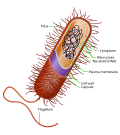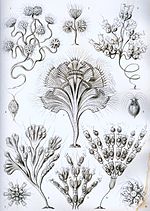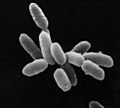 | include the earlier two-empire system (with the empires Prokaryota and Eukaryota), and the eocyte hypothesis (with two domains of Bacteria and Archaea... 12 KB (1,299 words) - 11:47, 12 April 2024 |
 | (or DRIP clade, or Mesomycetozoea) are a small group of Opisthokonta in Eukaryota (formerly protists), mostly parasites of fish and other animals. They... 9 KB (776 words) - 18:54, 22 January 2024 |
 | Archaebacteria). Organisms with nuclei are placed in a third domain, Eukaryota. Prokaryotes evolved before eukaryotes, and lack nuclei, mitochondria... 44 KB (4,769 words) - 23:36, 12 April 2024 |
 | Kingdom (biology) (redirect from Kingdoms of the Eukaryota) later be expanded to the three-domain system of Archaea, Bacteria, and Eukaryota. The differences between fungi and other organisms regarded as plants... 75 KB (4,869 words) - 14:08, 31 March 2024 |
single kingdom Bacteria (a kingdom also sometimes called Monera), with the Eukaryota for all organisms whose cells contain a nucleus. A small number of scientists... 69 KB (6,804 words) - 03:00, 15 April 2024 |
 | 2018. Retrieved 28 September 2017. Lineage( full ) cellular organisms; Eukaryota; Opisthokonta; Metazoa; Eumetazoa; Bilateria; Protostomia; Ecdysozoa;... 6 KB (584 words) - 13:03, 15 February 2024 |
Prokaryotes and Eukaryotes to the Three-domain system of the domains Eukaryota, Bacteria and Archaea. Wheelis's research interests include the history... 3 KB (230 words) - 23:15, 20 June 2022 |
 | Bifidobacterium animalis which is present in the human large intestine Eukaryota are organisms whose cells contain a membrane-bound nucleus. They include... 15 KB (1,602 words) - 00:49, 22 March 2024 |
 | Archaea and Bacteria, only contain microorganisms. The third domain Eukaryota includes all multicellular organisms as well as many unicellular protists... 73 KB (7,720 words) - 14:19, 4 March 2024 |
Thomas Cavalier-Smith: Animalia, Plantae, Fungi, Chromista, Protozoa and Eukaryota In Chinese history, six of the Seven Warring States that formed an alliance... 731 bytes (102 words) - 11:13, 7 March 2024 |
Archaea (originally Archaebacteria); Bacteria (originally Eubacteria); Eukaryota (including protists, fungi, plants, and animals) These domains reflect... 37 KB (4,041 words) - 01:15, 23 April 2024 |
 | Paratrimastix, F), parabasalids (trichomonads, P/S, hypermastigids, S) Eukaryota incertae sedis : haptophytes (F/A), cryptophytes (F/A), kathablepharids... 12 KB (1,240 words) - 11:46, 17 April 2024 |
 | is clear that the malawimonads are a monophyletic clade at the base of Eukaryota, but there is no consensus on the specific relationships between other... 6 KB (552 words) - 00:28, 6 April 2024 |
Smallest organisms (section Eukaryotes (Eukaryota)) The smallest organisms found on Earth can be determined according to various aspects of organism size, including volume, mass, height, length, or genome... 46 KB (5,139 words) - 23:46, 29 March 2024 |
 | that the Eukaryota are deep within Asgard, as sister of Hodarchaeales within the Heimdallarchaeia. In the depicted scenario, the Eukaryota are deep in... 33 KB (2,829 words) - 23:58, 30 March 2024 |
 | member of the family Bombinatoridae Scientific classification Domain: Eukaryota Kingdom: Animalia Phylum: Chordata Class: Amphibia Clade: Salientia Order:... 6 KB (546 words) - 18:21, 3 January 2024 |
antiprotozoal when they really mean anti-protist. Protists are a supercategory of eukaryota which includes protozoa. The mechanisms of antiprotozoal drugs differ... 5 KB (507 words) - 23:48, 21 October 2023 |
 | three-domain system. It classified cellular life into Prokaryota and Eukaryota as either "empires" or "superkingdoms". When the three-domain system was... 3 KB (833 words) - 21:52, 3 June 2022 |
 | or habitat conditions. Fungi are the only group of organisms in the Eukaryota domain that can survive at temperature ranges of 50–60 °C. Thermophilic... 12 KB (1,256 words) - 21:24, 31 March 2024 |
the second step. In other organisms (Bacteria, Archaea and the other Eukaryota), the first three steps are done by three different enzymes. Pyrimidines... 9 KB (771 words) - 20:20, 4 January 2024 |










